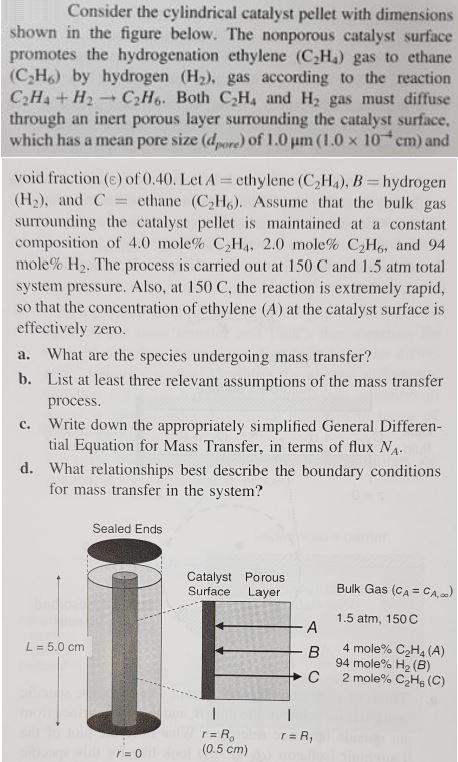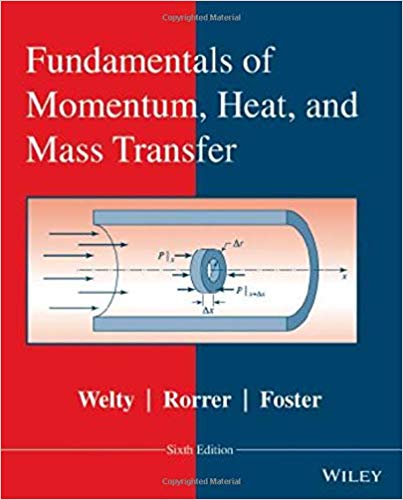Consider the cylindrical catalyst pellet with dimensions shown in the figure below. The nonporous catalyst surface...
Fantastic news! We've Found the answer you've been seeking!
Question:

Transcribed Image Text:
Consider the cylindrical catalyst pellet with dimensions shown in the figure below. The nonporous catalyst surface promotes the hydrogenation ethylene (C₂H₂) gas to ethane (C₂H6) by hydrogen (H₂). gas according to the reaction C₂H4 + H₂ 1 C₂H6. Both C₂H4 and H₂ gas must diffuse through an inert porous layer surrounding the catalyst surface. which has a mean pore size (dpore) of 1.0 μm (1.0 x 10 cm) and void fraction (e) of 0.40. Let A = ethylene (C₂H4), B = hydrogen (H₂), and C= ethane (C₂H). Assume that the bulk gas surrounding the catalyst pellet is maintained at a constant composition of 4.0 mole% C₂H4, 2.0 mole % C₂H6, and 94 mole% H₂. The process is carried out at 150 C and 1.5 atm total system pressure. Also, at 150 C, the reaction is extremely rapid, so that the concentration of ethylene (A) at the catalyst surface is effectively zero. a. What are the species undergoing mass transfer? b. List at least three relevant assumptions of the mass transfer process. c. Write down the appropriately simplified General Differen- tial Equation for Mass Transfer, in terms of flux NA. What relationships best describe the boundary conditions for mass transfer in the system? d. L = 5.0 cm Sealed Ends Catalyst Porous. Surface Layer 1 r = R₁ r = 0 (0.5 cm) A B C I r = R₁ Bulk Gas (CA = CA,00) 1.5 atm, 150 C 4 mole% C₂H4 (A) 94 mole% H₂ (B) 2 mole% C₂H, (C) Consider the cylindrical catalyst pellet with dimensions shown in the figure below. The nonporous catalyst surface promotes the hydrogenation ethylene (C₂H₂) gas to ethane (C₂H6) by hydrogen (H₂). gas according to the reaction C₂H4 + H₂ 1 C₂H6. Both C₂H4 and H₂ gas must diffuse through an inert porous layer surrounding the catalyst surface. which has a mean pore size (dpore) of 1.0 μm (1.0 x 10 cm) and void fraction (e) of 0.40. Let A = ethylene (C₂H4), B = hydrogen (H₂), and C= ethane (C₂H). Assume that the bulk gas surrounding the catalyst pellet is maintained at a constant composition of 4.0 mole% C₂H4, 2.0 mole % C₂H6, and 94 mole% H₂. The process is carried out at 150 C and 1.5 atm total system pressure. Also, at 150 C, the reaction is extremely rapid, so that the concentration of ethylene (A) at the catalyst surface is effectively zero. a. What are the species undergoing mass transfer? b. List at least three relevant assumptions of the mass transfer process. c. Write down the appropriately simplified General Differen- tial Equation for Mass Transfer, in terms of flux NA. What relationships best describe the boundary conditions for mass transfer in the system? d. L = 5.0 cm Sealed Ends Catalyst Porous. Surface Layer 1 r = R₁ r = 0 (0.5 cm) A B C I r = R₁ Bulk Gas (CA = CA,00) 1.5 atm, 150 C 4 mole% C₂H4 (A) 94 mole% H₂ (B) 2 mole% C₂H, (C)
Expert Answer:
Answer rating: 100% (QA)
a The species undergoing mass transfer are ethylene C2H4 hydrogen H2 and ethane C2H6 b Relevant assu... View the full answer

Related Book For 

Fundamentals Of Momentum Heat And Mass Transfer
ISBN: 9781118947463
6th Edition
Authors: James Welty, Gregory L. Rorrer, David G. Foster
Posted Date:
Students also viewed these accounting questions
-
A two-jaw clutch has the dimensions shown in the figure and is made of ductile steel. The clutch has been designed to transmit 2 kW at 500 rev/min. Find the bearing and shear stresses in the key and...
-
The bridge support shown in the figure below is the top half of an ellipse. Assuming that a coordinate system is superimposed on the drawing in such a way that point Q, the center of the ellipse, is...
-
A 1.0-cm-diameter horizontal cylinder is maintained at a constant surface temperature of 400 K and exposed to oxygen at 300 K and 1.5 atm. The length of the cylinder is 125 cm. Calculate the heat...
-
On the cost of goods manufactured schedule, depreciation onfactory equipment... A. is not listed because it is not a product cost. B. is not an inventoriable cost. C. is not listed because it is...
-
Briefly identify and describe the stages of development for a new venture.
-
What role, if any, should the HR department play in attempting to harmonize pay across a multinational organization? Explain. Twenty-two out of twenty-eight governments of the European Union member...
-
Although the customer loyalty project at Petrie Electronics had gone slowly at first, the past few weeks had been fast-paced and busy, Jim Watanabe, the project manager, thought to himself. He had...
-
The Northshore Bank is working to develop an efficient work schedule for full-time and part-time tellers. The schedule must provide for efficient operation of the bank including adequate customer...
-
Ruler Formula Bar Normal Page Break Page Custom Preview Layout Views Gridlines Headings Zoom 100% Zoom To Selection Window Macros Workbook Views Show Zoom Macros A A1 V A B D E F G H 4 Assume That...
-
Dorchester, Ltd. is an old-line confectioner specializing in high-quality chocolates. Through its facilities in the United Kingdom, Dorchester manufactures candies that it sells throughout Western...
-
Read the case study below, then recommend 3 leadership approaches that could be used to help the CEO of Devise Products Unlimited (DPU) in better managing his company an d staff which mainly consist...
-
Kareem received a retroactive salary payment of $100,000 and has decided to invest the full amount in Make Some Money Limited (MSM) stock. In an effort to maximize his returns, he has decided to...
-
iid 2 1. Consider a 3 year investment with annual effective rates 11, 12, 13 in each year respectively. Assume that the rates are independent and identically distributed, and that (1+1) In N(, o),...
-
The total electric flux from a cubical box of side 23.0 cm is 1.55x103 N m/C. Part A What charge is enclosed by the box? Express your answer to three significant figures and include the appropriate...
-
Consider the following two assets. Returns on asset 1 has a mean of and standard deviation of 1. Returns on asset 2 has a mean of 2 and standard deviation of 2. The correlation coefficient p1,2...
-
Draw a complete flowchart for a program that can display midterm results of three students. i) ii) Calculate the percentage marks obtained, and Print student's matric number and their percentage of...
-
Prepare a brief report on what you believe are the THREE most significant critical success factors (CSFs) for effective benchmarking of health and safety management performance.
-
Draw the appropriate control flow graph of the given pseudocode.Make sure to only use one number for blocks of code which are all sequential and when the first line is executed, all of those lines...
-
It is common practice to treat wooden telephone poles with tar-like materials to prevent damage by water and insects. These tars are cured into the wood at elevated temperatures and pressures....
-
A solar energy collector measuring 20 20 ft is installed on a roof in a horizontal position. The incident solar energy flux is 200 Btu/h ft 2 , and the collector surface temperature is 150F. What...
-
A tungsten filament, radiating as a gray body, is heated to a temperature of 4000R. At what wavelength is the emissive power maximum? What portion of the total emission lies within the visible-light...
-
For the probability distribution in Exercise 14, find the sampling distribution of the sample mean for all samples of size \(n=2\). (Hint: The sample means will be the same as given in Figure 3.7,...
-
Minitab can also be used to create a graphical summary of a given variable. The graphical summary can be found by selecting the Stat menu; under Basic Statistics a. Using Minitab, create a graphical...
-
Often we may be interested in comparing the amount of variability between two different data sets. This can be done using the sample coefficient of variation \((C O V)\), which is a percentage that...

Study smarter with the SolutionInn App


